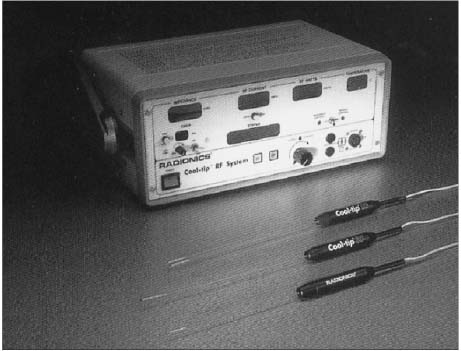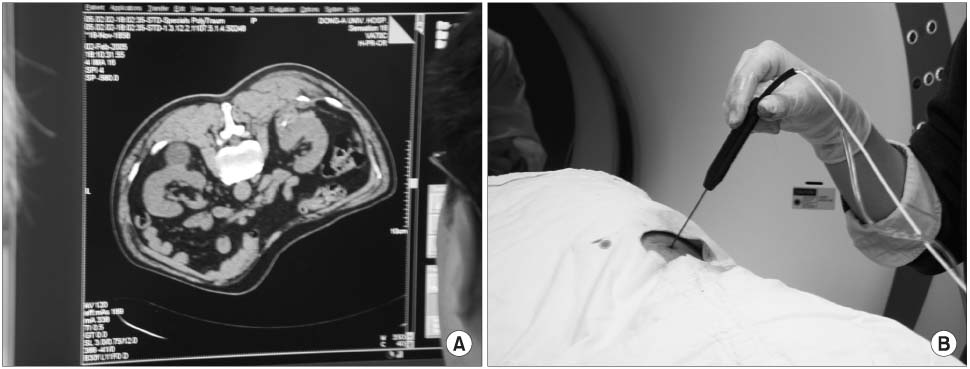Korean J Urol.
2006 Mar;47(3):244-251. 10.4111/kju.2006.47.3.244.
Initial Experience of Radiofrequency Ablation of Renal Tumor
- Affiliations
-
- 1Department of Urology, Diagnostic Radiology, Dong-A University School of Medicine, Busan, Korea. sunggt@daunet.donga.ac.kr
- KMID: 2294169
- DOI: http://doi.org/10.4111/kju.2006.47.3.244
Abstract
-
PURPOSE: We wanted to report the our early experience with performing nephron-sparing radiofrequency ablation (RFA) of renal tumor.
MATERIALS AND METHODS
Three percutaneous RFAs were performed under combined computed tomography (CT) and ultrasonogram guided, and two intraoperative ultrasonograpy-guided laparoscopic RFAs were performed since June 2004. The treatment indications were localized, small (<4cm), solid renal masses in elderly patients and also the same type masses in the patients with comorbid conditions. The follow-up studies included physical examination, CBC, serum creatinine, urine analysis and kidney CT, and these were performed at day 1, 1 week, 1 month, 3 months, 6 months and 1 year after ablation, and then semi-annually thereafter. The mean follow-up duration was 8.8 months (range: 5-12 months).
RESULTS
All five patients underwent successful RFA without any serious events. One patient had a mild perinephric hematoma and another patients had mild gross hematuria postoperatively. With a mean follow-up of 8.8 months, none of the patients showed any residual tumor on follow-up contrast-enhanced CT after the final tumor ablation. Complete tumor ablation was achieved after a single treatment session in 80% of the patients and in 20% of patients after the subsequent ablation sessions.
CONCLUSIONS
Percutaneous or laparoscopic RFA is a promising nephron-sparing treatment for selected patients with small renal mass. Contrast-enhanced CT performed immediately after ablation is a reliable method to exclude residual viable tumor. The ultimate role for this modality will continue to evolve and this warrants further studies.
Keyword
MeSH Terms
Figure
Reference
-
1. Livrghi T, Goldberg SN, Lazzaroni S, Meloni F, Ierace T, Solbiati L, et al. Hepatocellular carcinoma: radio-frequency ablation of medium and large lesions. Radiology. 1999. 214:761–768.2. Walther MM, Shawker TH, Libutti SK, Lubensky I, Choyke PL, Venzon D, et al. A phase 2 study of radio frequency interstitial tissue ablation of localized renal tumors. J Urol. 2000. 163:1424–1427.3. Ljungberg B, Alamdari FI, Holmberg G, Granfors T, Duchek M. Radical nephrectomy is still preferable in the treatment of localized renal cell carcinoma. A long-term follow-up study. Eur Urol. 1998. 33:79–85.4. Lau WK, Blute ML, Weaver AL, Torres VE, Zincke H. Matched comparison of radical nephrectomy vs nephron sparing surgery in patients with unilateral renal cell carcinoma and a normal contralateral kidney. Mayo Clin Proc. 2000. 75:1236–1242.5. Clark PE, Schover LR, Uzzo RG, Hafez KS, Rybicki LA, Novick AC. Quality of life and psychological adaptation after surgical treatment for localized renal cell carcinoma: impact of the amount of remaining renal tissue. Urology. 2001. 57:252–256.6. Moll V, Becht E, Ziegler M. Kidney preserving surgery in renal cell tumors: indications, techniques and results in 152 patients. J Urol. 1993. 150:319–323.7. Lerner SE, Hawkins CA, Blute ML, Grabner A, Wollen PC, Eickholt JT, et al. Disease outcome in patients with low stage renal cell carcinoma treated with nephron sparing or radical surgery. J Urol. 1996. 155:1868–1873.8. Park KJ, Kwak C, Lee SB, Kim DY, Chung JS, Lee SE. Nephron sparing surgery in the management of renal cell carcinoma. Korean J Urol. 2000. 41:8–14.9. Filipas D, Fichtner J, Spix C, Black P, Carus W, Hohenfellner R, et al. Nephron sparing surgery of renal cell carcinoma with a normal opposite kidney: long-term outcome in 180 patients. Urology. 2000. 56:387–392.10. Delakas D, Karyotis I, Daskalopoulos G, Terhorst B, Lymberopoulos S, Cranidis A. Nephron-sparing surgery for localized renal cell carcinoma with a normal contralateral kidney: a European three-center experience. Urology. 2002. 60:998–1002.11. Bosniak MA. The use of the Bosniak classification system for renal cysts and cystic tumors. J Urol. 1997. 157:1852–1853.12. Hafez KS, Fergany AF, Novick AC. Nephron sparing surgery for localized renal cell carcinoma: impact of tumor size on patient survival, tumor recurrence and TNM staging. J Urol. 1999. 162:1930–1933.13. Uzzo RG, Novick AC. Nephron sparing surgery for renal tumors: indications, techniques and outcomes. J Urol. 2001. 166:6–18.14. Li QL, Guan HW, Zhang QP, Zhang LZ, Wang FP, Liu YJ. Optimal margin in nephron-sparing surgery for renal cell carcinoma 4cm or less. Eur Urol. 2003. 44:448–451.15. Rendon RA, Kachura JR, Sweet JM, Gartner MR, Sherar MD, Robinette M, et al. The uncertainty of radio frequency treatment of renal cell carcinoma: findings at immediate and delayed nephrectomy. J Urol. 2002. 167:1587–1592.16. Ogan K, Jacomides L, Dolonatch BL, Rivera FJ, Dellaria MF, Josephs SC, et al. Percutaneous radiofrequency ablation of renal tumors: technique, limitations, and morbidity. Urology. 2002. 60:954–958.17. Gervais DA, McGovern FJ, Wood BJ, Goldberg SN, McDougal WS, Mueller PR. Radio-frequency ablation of renal cell carcinoma: early clinical experience. Radiology. 2000. 217:665–672.18. Su LM, Jarrett TW, Chan DY, Kavoussi LR, Solomon SB. Percutaneous computed tomography-guided radiofrequency ablation of renal masses in high surgical risk patients: preliminary results. Urology. 2003. 61:4 Suppl 1. 26–33.19. Walther MM, Shawker TH, Libutti SK, Lubensky I, Choyke PL, Venzon D, et al. A phase 2 study of radio frequency interstitial tissue ablation of localized renal tumors. J Urol. 2000. 163:1424–1427.20. Pavlovich CP, Walther MM, Choyke PL, Pautler SE, Chang R, Linehan WM, et al. Percutaneous radio frequency ablation of small renal tumors: initial results. J Urol. 2002. 167:10–15.21. Mahnken AH, Gunther RW, Tacke J. Radiofrequency ablation of renal tumors. Eur Radiol. 2004. 14:1449–1455.
- Full Text Links
- Actions
-
Cited
- CITED
-
- Close
- Share
- Similar articles
-
- Radiofrequency Ablation of Hepatic Cysts: Case Report
- Spontaneous Regression of Pulmonary and Adrenal Metastases Following Percutaneous Radiofrequency Ablation of a Recurrent Renal Cell Carcinoma
- A Case of Chronic Radiodermatitis following Radiofrequency Catheter Ablation for Atrial Fibrillation
- Radiofrequency Thermal Ablation of Hepatocellular Carcinomas
- Assessment of Local Tumor Progression After Image-Guided Thermal Ablation for Renal Cell Carcinoma





